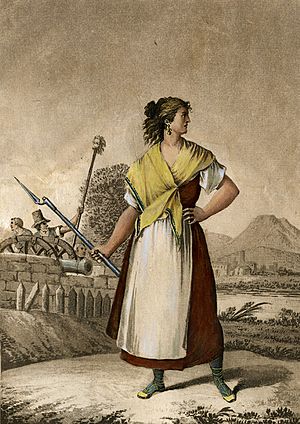Casta Álvarez facts for kids
Quick facts for kids
Casta Álvarez Barceló
|
|
|---|---|

An engraving of Casta Álvarez Barceló by Juan Gálvez and Fernando Brambila
|
|
| Birth name | Casta Álvarez Barceló |
| Born | 1786 Zaragoza, Spain or Orán, Algeria |
| Died | April 29, 1846 Cabañas de Ebro, Zaragoza, Spain |
| Allegiance | Spain |
| Battles/wars | Peninsular War |
| Awards | Escudo de Distinción, Escudo de defensor de la Patria . |
Casta Álvarez Barceló (born in 1786 – died April 29, 1846) was a brave Spanish woman from Aragon. She became a hero during the Spanish War of Independence (1808-1814), which was part of the Peninsular War. She is famous for her amazing courage during the First siege of Zaragoza. She inspired everyone defending the city by fighting off French soldiers all by herself. Her story became very popular through special pictures called engravings, published in 1812 and 1813. Because of her bravery, she received a special payment from Ferdinand VII of Spain, the King of Spain. Later, her body was moved with great honor.
Contents
Her Early Life and the War
Casta Álvarez Barceló was born in 1786. Her parents were from a town called Figueruelas. She might have been born in Zaragoza, Spain, or in Orán, Algeria. But by 1808, she was living in Zaragoza.
In 1808, Napoleon sent French and Polish soldiers to Spain. They wanted to stop people from fighting back against French rule. On June 15, 1808, these soldiers arrived at Zaragoza, ready to attack the city.
The attack on Zaragoza was very harsh. There was fighting in the streets, and the city was surrounded to try and starve its people. Many people died from sickness as well as from the fighting. The city's defenders, led by José de Palafox y Melci, were not as well-trained as the French troops. They fought very hard to protect their home. Casta Álvarez Barceló helped by organizing food and supplies for the people and soldiers.
Casta's Brave Actions
During the fighting, Casta was near a city gate called the Puerta del Carmen. She suddenly found herself surrounded by French cavalry (soldiers on horseback). Instead of running away, she picked up a gun that someone had dropped. She started firing it at the French soldiers. They were very surprised by how fierce she was and how well she used the weapon. Because of her bravery, the French soldiers retreated.
Her actions greatly inspired the Spanish defenders. The French forces were pushed back from that part of the city. Casta also took part in the second siege of Zaragoza. Again, her strong spirit and fighting skills encouraged the people of Zaragoza. They saw her as a true hero.
Life After the War and Her Legacy
After the French took over Zaragoza, Casta moved with her parents to a town called Cabañas de Ebro. In 1814, after the war ended, she married a wealthy farmer. She lived a quiet life after that. Casta passed away at the age of 60 on April 29, 1846.
To honor her bravery, Casta Álvarez Barceló received two special awards: the Escudo de Distinción (Shield of Distinction) and the Escudo de Defensor de la Patria (Shield of a Defender of the Fatherland). She also received a special payment from King Ferdinand VII of Spain, starting in 1815.
Even though the Spanish were eventually defeated at Zaragoza, Casta Álvarez Barceló became a very important national hero. She was remembered alongside other brave women like Agustina de Aragón. These female fighters inspired many, including the famous artist Francisco Goya in his artworks. Her story was shared across Europe, especially in Britain. Pictures of her became popular through engravings by Juan Gálvez and Fernando Brambila, published in 1812 and 1813. A painting of her from 1875 was also displayed in Zaragoza.
In 1908, one hundred years after the siege, her body was moved to a special chapel with great honor. A road in Zaragoza was also named after her.
See also
- Giuseppa Bolognara Calcagno
- Juana Galán
- María Mayor Fernández de Cámara y Pita
- In Spanish: Casta Álvarez para niños
Sources


